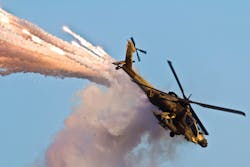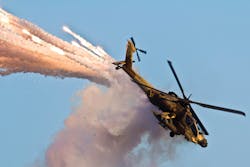Army wants dual-use aircraft infrared sensor for missile warning and situational awareness
FORT BELVOIR, Va. - Officials of the Army Contracting Command at Fort Belvoir, Va., approached industry last month for the Digital Dual Use Sensor (DDUS) project, which is to be a high-pixel-count dual-band infrared sensor module capable of providing high-quality imagery for threat warning and for pilotage and situational awareness applications on future Army helicopters and fixed-wing aircraft.
The goal is to combine into one compact sensor module the imaging ability to detect and locate threats such as ground-to-air and air-to-air missiles via passive thermal imaging, as well as to help pilots navigate in bad weather, at night, and in other degraded-visibility conditions.
This single dual-use, electro-optical sensor will require large-format, dual-band infrared imaging sensors and high-frame rate, high dynamic range, multifunction readout integrated circuits (ROICs).
The Army Contracting Com-mand issued a sources-sought notice on behalf of the Army Research Development and Engineering Command (RDECOM), Communications and Electronics Research and Development Engineering Center (CERDEC), Night Vision Electronics Sensors Directorate (NVESD) at Fort Belvoir, Va.
Army researchers point out that integrating these sensor compo- nents and image-processing algorithms will require careful management of the engineering design trades for each sensor component.
Specifically, Army researchers are looking for 2,048-by-2,048-pixel medium-wave and long-wave infrared focal plane arrays with pixels smaller than 12 microns. These sensors should have high quantum efficiency, low dark current, and low spatial and spectral pixel crosstalk.
The readout circuit is to match the focal plane array format, with high injection efficiency, low noise, low power dissipation, true full well capacity greater than 8e7 electrons, 18 bits of dynamic range, and non-linearity smaller than 0.1 percent. The ROIC should be linear through the whole dynamic range, and not involve logarithmic compression.
Researchers are considering only off-the-shelf solutions, as no development funding is available.

